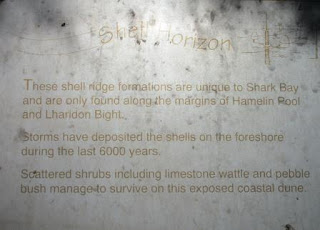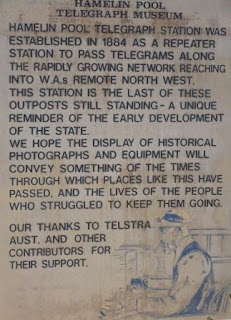7am
22 degrees, clouds in the east but mostly sunny. Wind still blowing. Forecast
is for the stronger winds to settle tomorrow so hopefully we won’t get blown to
pieces when we explore Shark Bay region.
Drove
up to the Overlander Roadhouse – 158.9c/l here for diesel. Turned off into the
Shark Bay World Heritage Area. The brochure lists why it has been classed a
World Heritage site.
Continued
down the road past the Hamelin Station Stay and turned into the track down to
the old Telegraph Station which is now a caravan park. We don’t normally do
caravan parks but free camping is a bit limited up the WA coast. It is an open
plan style so we don’t feel crowded and as this is the off season we should be
fine. There is a walk from here to check out the Stromatolites and we can check
out the Telegraph Station museum too. Friendly chap greeted us. His mother owns
the place but he and his mate are looking after it for her for a while.
We
chose our spot and set up. The telegraph station is the building on the right. Warming
up quickly – forecast is for 37 maximum while at Denham it is only 30.
Sprinklers are keeping the grass nice and green and there is a pool as the bay
is very, very salty.
Rang
Mum and Dad. Mum’s knee is feeling good and are settling in to watch the tennis
matches she has taped.
A
map of the area – we are at the bottom of the first bay. It is over $400 to go
across to Dart Hartog Island so we will skip that as we will be exploring all
the other area.
Had
a cuppa then went for a walk to check out the Stromatolites. They were first
discovered by some geologists in June 1954.
I
looked up the photos and information I took about the Thrombolites that grew at
Lake Clifton below Mandurah. Same but softer and are a different shape to the
Stromatolites.
First
we read the information about the wool shed that was built here in 1923 so they
could load their wool onto the ships. The shed was dismantled in 1968 and used
for the polocrosse club.
A
long boardwalk takes us over the stromatolites now whereas in the old days they
just drove over them with their wagons etc.
Panning
left to right – the land in the distance is the Nanga Peninsula.
Walked
along the boardwalk reading the signs.
Another
couple walked down to the edge then sent up their drone which buzzed loudly
over our heads. Then they went back to their car and disappeared – so much for
seeing the sights.
The
ones with orange showing are Stromatolite fossils.
More
signs.
The
flat mats. You can still see the indents of where the wagons were dragged out
by camels to load the wool bales onto the dingys which would row back out to
the waiting Lighters.
The
lumpier Stroms that are still growing at a rate of 0.3mm a year.
The
tide was out but we did spot a few little fish (little whiting?) swimming
around and a cute little school of baby fish.
Back
on the beach which is millions of crushed shells.
Now
to follow the Boolagoorda Walking Track with more information boards.
Interesting fact about the water of the pool as it flows in but hardly flows
back out over the ‘sill’.
A
lonely grave indeed. Shame they haven’t put a memorial up for his mate even
though they never recovered his body. Note the headstone is made from the shell
blocks carved out of the quarry on the beach near here.
Interesting
information about how the shell stone has formed from all the little shells.
Around
to the quarry.
Up
the white sand/shell dune to where the old navigation flag pole is. Some brochures call this Flint Hill, others say Flagpole Hill.
Looking
down over the caravan park and old telegraph master’s house.
Nice
view of part of Hamelin Pool.
Looking
further to the east is the main coastline.
Steve
spotted two white goats trotting through the scrub.
Heading
back to the van park we passed a small white grave. Unfortunately a new
headstone had been installed and the wrong inscription was put on – probably
because the old one had perished and the person wrote the wrong dates etc. His
name was Onslow Thomas Carmody and he died in 1883 aged 8 months.
Some
shell bricks at the back of the old Station Master’s house.
Steve
checked out the bore hole which is pumped up to the tank. One of the old
Telegraph poles is still standing.
Over
near the toilet block was a heap of signs. Obviously the old ones that have
been upgraded with the ones we have just read and a few about the telegraph
station etc. I think these ones explained things better.
I
like this one about the telegraph line and the last bit about the swaggie
cutting the line so he could get a lift!
Had
lunch then I cooked our favourite lamb dish in the Ecopot for dinner.
Wandered
over to the museum which is in the old Telegraph Station. The office and café
are in the old Station Master’s house.
One
of the chaps opened it up for us and turned on the DVD presentation. Very
informative about the Stromatolites – explained things well. They have some
growing in a tank and you can see the oxygen bubbles on them ready to pop up to
the surface. The DVD also talked about the telegraph station.
We
wandered around checking out the displays. These are the saws used to cut the
shell blocks.
In
the next room was all the telegraph station information.
A
big picture on the wall caught my attention. Clarence “Adgee” Cross was the
last linesman to work from Hamelin Pool Telegraph Station. His wife, Grace was
the postmistress from 1948 to 1963. Apparently he was called out to do a repair
and had to go across a flooded river so he took off his clothes to keep them
dry to put on when he had finished the job. Interestingly though there are two
other chaps in the photo – obviously they didn’t mind getting their clothes
wet!
Great
photo of the wool being loaded onto the dingy from the camel wagon to be rowed
out to the ‘Lighter’ waiting in the deeper water of Hamelin’s Pool.
Boxes
lined the walls – I think made by school children to depict the various ships
wrecked on the WA coast. Above them were posters about the ships.
On
the tip of Dirt Hartog Island is Cape Inscription which is the site of the
first recorded landing of Europeans in Australia. This is a replica of the
plate Dirt inscribed and left there on a wooden post. In 1697 another Dutch
explorer, Willem de Vlamingh found the plate and replaced it with another one
and returned Dirt’s back to Holland.
We
went into the old Station Master’s house (now café) to let the chap know we
were finished. I found some more information about the child’s grave we saw before.
We
had a cuppa then went for a dip in the pool. Very cold but it was very
refreshing after we cracked the ice on top – well it felt like it. The little
swallows and bee-eaters were zooming around dipping into the pool too. Three
Perth men arrived for a dip too and we chatted with them about fishing etc.
They are heading out to Steep Point to try and catch some Spanish and Shark
Mackerel using helium balloons to take their lines out from the 15 ft cliffs
they will be standing on. Will be interesting to see when we get out there.
They said to get prawns as bait to catch the whiting around here – looking
forward to some nice fish dinners.
Dried
off as we walked back to the beach. Found another couple of tombstones nearby –
memorials rather than graves. One was a recent owner – the other just said Ash.
I
thought the tide might have come in to under the boardwalk but Steve thinks it
had gone further out.
I
worked on my blog for a while – trying to keep on top of it now we are touring
mode again. Had our drinks as the cool wind blew and some clouds came over the
sun.
A
couple next to us in a camper arrived back from their day visit to Steep Point
so Steve went over to see how the track was.
Walked
up the white hill covered in tiny shells to watch the sun set.
Beautiful
with just the right amount of cloud to bring out the colour.
The
wind has swung around and is still blowing well but isn’t as cold tonight.














































































































